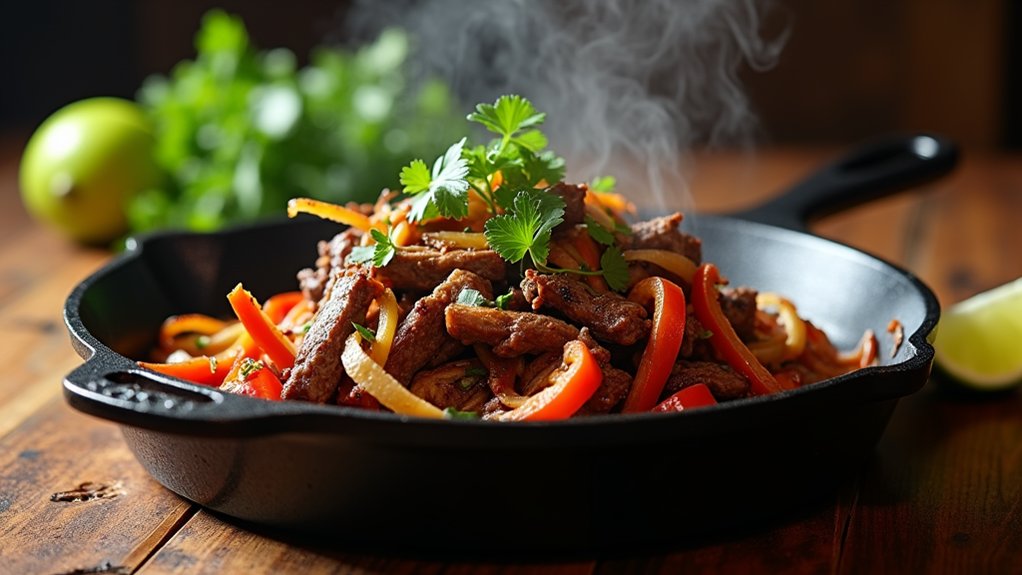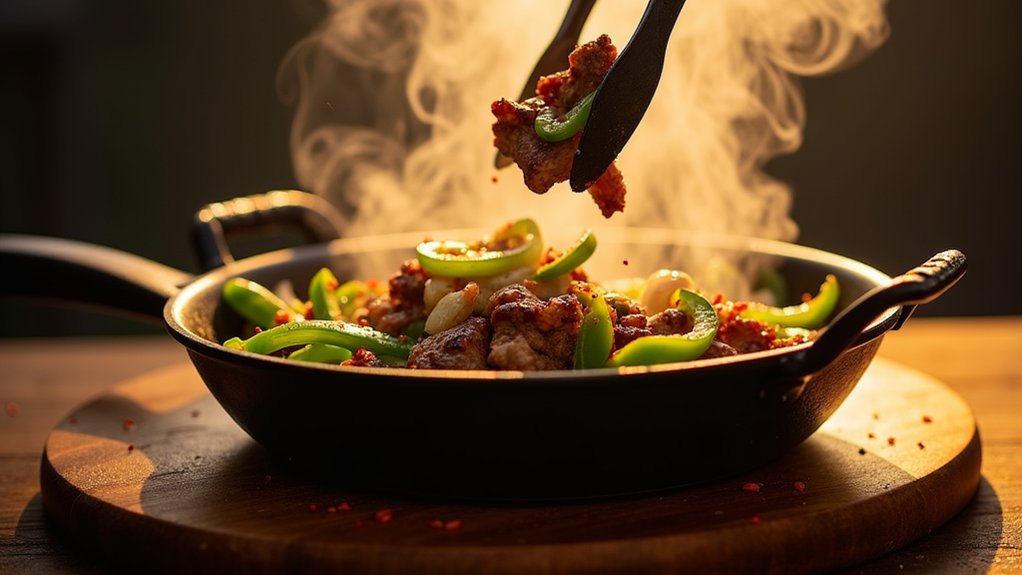You’re fixin’ to get your fajita fix in South Texas, where the cowboys are tough and the flavors are tougher! This iconic dish originated in the 1930s with Mexican ranch workers throwin’ skirt steak and entrails on the grill, and it’s been a wild ride ever since. You’ll need the essentials: olive oil, lime juice, and spices for the marinade, bell peppers and onions for added crunch, and small flour tortillas to wrap it all up. Now, you’re probably wonderin’ what other secrets are hiding in the heart of Texas… and trust us, it’s about to get a whole lot juicier!
Quick Facts
- Fajitas originated in West Texas in the late 1930s and early 1940s among Mexican ranch workers.
- Skirt steak is the traditional meat used in authentic South Texas fajitas, often marinated in olive oil, lime juice, and spices.
- Common vegetables used in South Texas fajitas include bell peppers and onions, often sautéed with garlic and spices.
- Fajitas are typically served on small flour tortillas with toppings such as shredded cheese, sour cream, guacamole, and salsa.
- The dish represents a blend of Texas cowboy traditions and Mexican culture, reflecting the region’s rich cultural heritage.
History

Let’s get this fiesta started! You’re about to plunge into the wild and delicious world of South Texas fajitas, and it all begins with their fascinating history. So, buckle up and get ready for some serious flavor.
As you might know, fajitas were born in the late 1930s and early 1940s in West Texas, where Mexican ranch workers created this mouthwatering dish using the least desirable parts of the cow. Yep, you read that right – these poor workers got stuck with the tough stuff, like skirt steak and entrails, but boy, did they turn lemons into lemonade! Their resourcefulness led to the creation of fajitas, which quickly became a staple in backyard gatherings and campfires.
Fast-forward to the 1960s, when Sonny Falcon, the “Fajita King,” popularized this delectable dish at rodeos and festivals. With time, fajitas gained momentum, and their cultural significance grew. They now reflect the beautiful blend of Texas cowboy traditions and Mexican flair, with regional variations that add an extra layer of excitement. Today, fajitas are a symbol of delicious freedom – the freedom to experiment with bold flavors and flavors that refuse to be contained. The dish eventually evolved to include various vegetables and meats like shrimp and chicken, making it a staple in many Tex-Mex restaurants.
Recipe

South Texas Fajitas are a staple of Tex-Mex cuisine, known for their bold flavors and lively colors. This dish originated in the Rio Grande Valley of South Texas, where Mexican and American cultures blended together to create a unique culinary tradition. Fajitas are a versatile dish that can be made with a variety of ingredients, including steak, chicken, shrimp, and vegetables.
To make authentic South Texas Fajitas, it’s essential to use the right ingredients and cooking techniques. This recipe uses skirt steak, which is the traditional cut of meat used in fajitas. The steak is marinated in a mixture of olive oil, lime juice, and spices, then grilled to perfection. The vegetables are sautéed in a large skillet with garlic and spices, and then combined with the cooked steak.
- 1 pound skirt steak
- 1/2 cup lime juice
- 1/4 cup olive oil
- 2 cloves garlic, minced
- 1 teaspoon chili powder
- 1 teaspoon ground cumin
- 1/2 teaspoon paprika
- 1/4 teaspoon cayenne pepper
- 1/2 teaspoon salt
- 1/4 teaspoon black pepper
- 2 large bell peppers, sliced
- 1 large onion, sliced
- 8 small flour tortillas
- Shredded cheese, sour cream, guacamole, and salsa
To cook the fajitas, start by heating a large skillet over medium-high heat. Add the sliced onions and bell peppers, and cook until they are soft and lightly charred. Then, add the garlic, chili powder, cumin, paprika, and cayenne pepper to the skillet, and cook for 1-2 minutes. Next, add the cooked steak to the skillet, and stir to combine with the vegetables.
To store leftovers, place them in an airtight container in the fridge for up to 3 days. To serve the fajitas, warm the flour tortillas by wrapping them in a damp paper towel and microwaving for 20-30 seconds. Assemble the fajitas by placing a portion of the steak and vegetable mixture onto a tortilla, and topping with shredded cheese, sour cream, guacamole, and salsa.
When cooking fajitas, it’s essential to use the right type of pan. A large cast-iron skillet or a griddle is ideal, as they retain heat well and can achieve a nice char on the vegetables. Additionally, be sure to let the steak rest for at least 10 minutes before slicing, as this will help the juices to redistribute and the meat to stay tender.
Final Thoughts

Now that you’ve perfected the art of cooking authentic South Texas Fajitas (or, at the very least, you’ve got the recipe written down somewhere), it’s time to put this beloved Tex-Mex dish into focus. As you’ve come to realize, fajitas are so much more than just a recipe – they represent a fusion of cooking techniques and a celebration of the region’s rich cultural significance.
You can almost smell the sizzling platter, can’t you? Here’s what’s probably going through your mind:
- The sizzle is real: Sizzling platters overflowing with lively veggies and savory meats, transporting the authentic taste of South Texas directly to your table.
- Cowboy boots and campfires: The time-honored tradition of backyard gatherings, campfires, and festive celebrations – all revolving around delicious, piping hot fajitas.
- Endless variations: You’ve now acquired the skills to marinate, grill, and arrange your fajitas however you like – the freedom to experiment with diverse flavors and tasty twists is at your fingertips.
- Flavors of freedom: Whether you stick to traditional recipes or invent your own, the sheer delight of devouring South Texas Fajitas embodies the carefree spirit that inhabits this beloved region.
The rise of fajitas to mainstream popularity surged in the 1970s, and it’s easy to see why they remain a favorite among locals and visitors alike.
Frequently Asked Questions
What Can Be Used as a Substitute for Beef in Fajitas?
A million alternatives await! You can ditch beef for chicken, shrimp, or loads of vegetarian alternatives like portobello mushrooms, tofu, and lentils – all packed with protein sources to fuel your freedom-filled fajita frenzy!
Are Fajitas a Healthy and Nutritious Meal Option?
You’re asking if fajitas are a healthy and nutritious meal option – yeah, if you employ decent fajita ingredients and aren’t completely clueless about grilling techniques, they actually can be a fairly solid choice.
Can I Prepare Fajitas Ahead of Time for a Big Gathering?
Free spirit that you are, prep tips are your BFF for a big gathering, but don’t worry, you can prep ahead without sacrificing flavor enhancement – just don’t overdo it, or you’ll end up with leather fajitas!
What Side Dishes Go Well With South Texas-Style Fajitas?
You’re in charge, so go wild with those side dishes – pile on the tortilla choices, from flour to corn, and get crazy with salsa variations, because who doesn’t love a little spice in their life?
Can I Make Fajitas Without Using a Cast-Iron Skillet?
Can you really live without that perfect sear? Of course, you can make fajitas without a cast-iron skillet! Try alternative cooking vessels and experiment with fajita cooking methods, then top with your favorite alternative fajita toppings – freedom to create!



